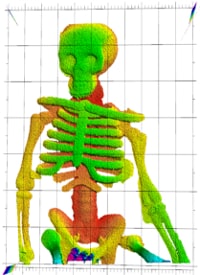A LIDAR system has produced 3D images of objects melting in fire, an advance that could lead to a more precise and safer way of measuring structural collapse during infernos.

Optical range measurements may help overcome practical challenges posed by structural fires, which are too hot to measure with conventional electromechanical sensors mounted on buildings.
Described in Optica, the US National Institute of Standards and Technology (NIST) demonstration used a commercial LIDAR system to map distances to objects melting behind flames that produced varying amounts of soot. The experiment measured 3D surfaces with a precision of 30 micrometres or better from 2m away. This level of precision meets requirements for most structural fire research applications, according to the Optica paper.
The NIST demonstration focused on pieces of chocolate and a plastic toy. "We needed something that doesn't melt too fast or too slow but you still see an effect," said project leader Esther Baumann.
LIDAR was shown to image objects when small amounts of soot are present in the flames. The method also works at a distance, from far enough away that the equipment is safe from the intense heat of a fire. In addition, the instrument can be compact and portable, relying on fibre optics and photodetectors.
In the 3D mapping system, a laser sweeps continuously across a band of optical frequencies. The initial laser output is combined with the reflected light from the target. The resulting ‘beat’ signals are detected, and this voltage is then analysed by digital signal processing to generate time-delay data equivalent to distance.
According to NIST, the researchers successfully applied LIDAR to measure and map 3D point clouds, even in a turbulent fire environment with strong signal scattering and distortion.
To make comparisons, the team made videos of the chocolate as it melted and images of a more complex plastic skeleton. For the melting chocolate, each LIDAR frame consisted of 7,500 points, which was sufficient to capture the chocolate deformation process. The plastic skeleton was barely visible in the conventional video, but the 3D point cloud revealed complex shapes – such as the toy’s ribcage and hips - otherwise hidden behind flames.
The researchers determined that the LIDAR system was fast enough to overcome signal distortions and that deflections of the laser beam due to the flames could be accommodated by averaging the signals over time, to retain high precision.
The initial experiments were conducted with flames 50mm wide on laboratory burners at the University of Colorado, Boulder. The preliminary results suggest that the LIDAR technique could be applied to larger objects and fires. The NIST team now plans to scale up the experiment, first to make 3D images of objects through flames about 1m wide. If successful, the team will look to make quantitative observations of larger structural fires.











Radio wave weapon knocks out drone swarms
I hope they have assessed how easy it is to shield a drone against the attack. Hopefully the shielding would add too much weight.